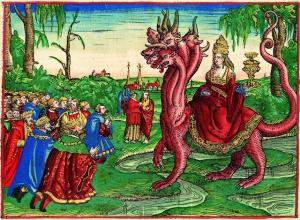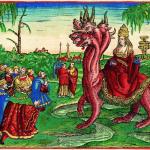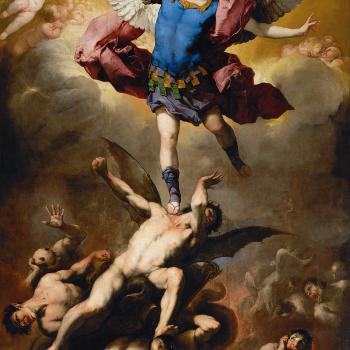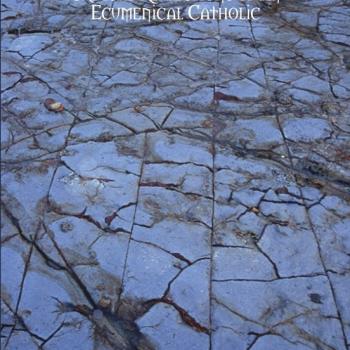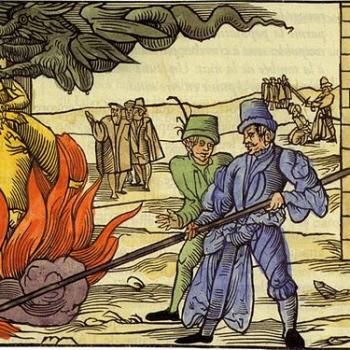Denominationalism; Salvation Outside the Church; Catholic & Protestant Baptism; Catholic Scholars; Doctrinal Development
The late Steve Hays (1959-2020) was a Calvinist (and anti-Catholic) apologist, who was very active on his blog, called Triablogue (now continued by Jason Engwer). His 695-page self-published book, Catholicism — a collection of articles from his site — has graciously been made available for free. On 9 September 2006, Hays was quite — almost extraordinarily — charitable towards me. He wrote then:
I don’t think I’ve ever accused him of being a traitor or apostate or infidel. . . . I have nothing to say, one way or the other, regarding his state of grace. But his sincerity is unquestionable. I also don’t dislike him. . . . I don’t think there’s anything malicious about Armstrong—unlike some people who come to mind. In addition, I don’t think I’ve ever said he was unintelligent. For the record, it’s obvious that Armstrong has a quick, nimble mind.
Two-and-a-half years later, starting in April 2009 and up through December 2011 (in the following quotations) his opinion radically changed, and he claimed that I have “an evil character,” am “actually evil,” “ego-maniac, narcissist,” “idolater,” “self-idolater,” “hack who pretends to be a professional apologist,” given to “chicanery,” one who doesn’t “do any real research,” “a stalwart enemy of the faith . . . no better than [the atheists] Richard Dawkins or Christopher Hitchens,” with an intent to “destroy faith in God’s word,” “schizophrenic,” “emotionally unhinged,” one who “doesn’t trust in the merit of Christ alone for salvation,” “has no peace of mind,” “a bipolar solipsist,” “split-personality,” and a “bad” man. He wasn’t one to mince words! See more gory details.
I feel no need whatsoever to reciprocate these silly and sinful insults. I just wanted the record to be known. I’ve always maintained that Hays was a very intelligent man, but habitually a sophist in methodology; sincere and well-meaning, but tragically and systematically wrong and misguided regarding Catholicism. That’s what I’m addressing, not the state of his heart and soul (let alone his eternal destiny). It’s a theological discussion. This is one of many planned critiques of his book (see my reasons why I decided to do this). Rather than list them all here, interested readers are directed to the “Steve Hays” section of my Anti-Catholicism web page, where they will all be listed. My Bible citations are from the RSV. Steve’s words will be in blue.
*****
[Chapter 3: Competing Paradigms]
Needle in a haystack
There’s a popular Catholic trope that goes something like this: Protestantism poses a dilemma for Protestants: why do you hope to find and join the right church when there are 30,000 candidates to sift through? There are several problems with this trope:
i) “The 30,000 denominations” is an artificial, misleading figure, as even Catholic apologists like Trent Horn admit. [p. 102]
I noted that this was an inaccurate number in an article dated 9-4-04. But it is certainly “many thousands” and anything beyond “one church” and “one faith” is simply biblically unsustainable. Denominationalism is an ongoing scandal and embarrassment that Protestantism can never resolve, because its rule of faith, sola Scriptura, doesn’t allow it to, and is the cause of the chaotic, relativist endless division and creation of new sects.
Catholics are unconsciously superimposing a Catholic paradigm on Protestants. It’s not a Protestant dilemma. It’s not a conundrum internal to Protestant theology. It’s only a dilemma if you take Catholic ecclesiology as the frame of reference. [p. 102]
This is untrue. It’s a “dilemma” and a “conundrum” and an outrage because it’s massively, grotesquely against biblical teaching. I could present all of that evidence again here, but I already have, so readers can simply follow the links:
Denominationalism and Sectarianism: An Anti-Biblical Scandal [1996]
Bible vs. Denominationalism and Against “Primary / Secondary” Doctrines [8-18-06]
“Reply to Calvin” #4: “Primary” & “Secondary” Doctrines [4-3-17]
Catholicism is True and Denominationalism is Anti-Biblical [National Catholic Register, 6-27-17]
Sectarianism & Denominationalism: Reply to Calvin #6 [12-19-18]
Does Sola Scriptura Create Chaos? (vs. Steve Hays) [5-15-20]
Unbiblical Denominations (vs. Lucas Banzoli) [6-9-22]
In Protestant theology, salvation isn’t contingent on locating and joining “the right church”. [p. 102]
Even if that is so, it doesn’t get Protestants off the hook, insofar as they brazenly defy and ignore biblical injunctions about unity and one Church only being in existence. They claim to be uniquely Bible followers. Very well, then, I challenge them to do that with regard to this topic.
In Protestant theology, salvation is mediated by Jesus, the Bible, and the Holy Spirit, not the church. While the church often plays a vital role in disseminating the Gospel, in Protestant theology, we’re not saved through the church in the traditional Catholic sense, where saving grace is piped through sacramental channels. [p. 102]
Hays claimed to speak for all “Protestant theology,” but he did not. John Calvin was a pretty influential Protestant leader, and Hays follows his theology (except I guess, in this matter). He wrote:
[T]here is no other means of entering into life unless she conceive us in the womb and give us birth, unless she nourish us at her breasts, and, in short, keep us under her charge and government, until, divested of mortal flesh, we become like the angels (Mt. 22:30). For our weakness does not permit us to leave the school until we have spent our whole lives as scholars. Moreover, beyond the pale of the Church no forgiveness of sins, no salvation, can be hoped for, as Isaiah and Joel testify (Isa. 37:32; Joel 2:32). . . . the abandonment of the Church is always fatal. (Institutes of the Christian Religion, IV, 1:4; cf. 1:8, 10, 20, 22)
Not only Calvin, but Martin Luther, the founder of Protestantism, believed this:
[O]utside the Christian church there is no truth, no Christ, no salvation. (Sermons II, ed. Hans J. Hillerbrand; Sermon for the Early Christmas Service, Luke 2 [:15-20], 25 December 1521, tr. John G. Kunstmann; in Luther’s Works, vol. 52)
And “sacramental channels” weren’t lacking in Protestantism, either, since both Luther and Calvin regarded baptism as a sacrament. For Luther it was regenerative, for Calvin maybe so (scholars differ). And both accepted their prior Catholic baptisms as valid (hence, neither was “rebaptized”). And the Catholic Church accepts the validity of Protestant baptism. Luther and Calvin both thought the Eucharist was a sacrament. Luther believed in the real presence and even in the adoration of the host. Calvin believed in a mystical presence of Jesus.
We don’t need to find a needle in a haystack. God doesn’t make salvation that elusive. We don’t need to comb through 30,000 straws to find the needle. It’s not about us finding God but God finding us. And the knowledge of salvation is available through multiple sources. In evangelical theology, you don’t have to be in union and communion with “the right church” to be in union and communion with God. [p. 102]
Apparently Luther and Calvin weren’t “evangelical” then, and we are to accept Oracle Lawgiver Steve Hays’ word on this rather than theirs. Both Luther and Calvin also absolutely detested and despised sectarianism and denominationalism, too, whereas Hays thought it was fine and dandy; not an issue of concern at all!
According to the traditional paradigm, you had to receive valid sacraments to be saved. Valid sacraments were dispensed by Roman Catholic priests. There was no salvation outside the Roman sacramental system. But that’s been shredded by post-Vatican II theology. [p. 102]
Sheer nonsense. I dealt to an extent with salvation outside the Church in an earlier installment. But here is the Council of Trent, Session VII (3 March 1547), Canons on Baptism:
CANON IV.-If any one saith, that the baptism which is even given by heretics in the name of the Father, and of the Son, and of the Holy Ghost, with the intention of doing what the Church doth, is not true baptism; let him be anathema.
Vatican II concurs with a more developed and complementary (not contradictory) version:
For men who believe in Christ and have been truly baptized are in communion with the Catholic Church even though this communion is imperfect. . . . it remains true that all who have been justified by faith in Baptism are members of Christ’s body, and have a right to be called Christian, and so are correctly accepted as brothers by the children of the Catholic Church. (Unitatis Redintegratio [1964], Decree on Ecumenism [3] )
Wouldn’t it have been nice if Hays had taken all of ten minutes to look up these things, rather than present a distorted, false version of what the Catholic Church supposedly teaches (that he read in a Jack Chick tract or something)? His research skills leave quite a bit to be desired, to put it mildly. It seems as if he just didn’t care whether he accurately portrayed Catholic doctrines or not. Rather, he lazily set forth a gross caricature, in order to make Catholicism look as unappealing and false as possible. In other words, the irrational emotions and bigotry of standard anti-Catholicism once again have caused an otherwise above-average mind to sink into silliness and falsehoods when describing the Catholic Church and her supposed teachings. But I have documented what we actually teach.
At best, Roman Catholicism has stretched the definition of “the Church” so that you can be in union and communion with “the Church” even if you’re completely ignorant of Catholic theology, have never received Catholic sacraments. [p. 103]
Hays exhibits his rank ignorance yet again. Protestant trinitarian baptism is a “Catholic” sacrament in our view. The Protestant has received a legitimate, bona fide sacrament, and one that regenerates and makes the recipient part of the Body of Christ. Now it’s quite true that a baptized Protestant might otherwise be very ignorant of Catholic theology, but they have received a Catholic sacrament, and in many cases, Protestant marriages are a second Catholic sacrament.
On that expansive redefinition, “the Church” becomes like oxygen: something universally available. Everyone can breathe it. [p. 103]
That’s untrue as well. One has to be baptized. There are billions of people in the world who never have been, so this is hardly “universal.”
Brother, can you paradigm?
As I was talking to this convert, I mentioned dramatic reversals in Catholic theology, such as salvation outside the church,
This is absolutely classic, textbook Hays sophistry (combined with a stubborn ignorance). There is no reversal of “no salvation outside the Church.” Dominus Iesus (2000), put out by the Congregation for the Doctrine of the Faith (CDF), under Cardinal Ratzinger (later, Pope Benedict XVI), reiterated the doctrine of “no salvation outside the Church.” It stated:
20. . . . Above all else, it must be firmly believed that “the Church, a pilgrim now on earth, is necessary for salvation: the one Christ is the mediator and the way of salvation; he is present to us in his body which is the Church. He himself explicitly asserted the necessity of faith and baptism (cf. Mk 16:16; Jn 3:5), and thereby affirmed at the same time the necessity of the Church which men enter through baptism as through a door”.77 This doctrine must not be set against the universal salvific will of God (cf. 1 Tim 2:4); “it is necessary to keep these two truths together, namely, the real possibility of salvation in Christ for all mankind and the necessity of the Church for this salvation”.78
The Church is the “universal sacrament of salvation”,79 since, united always in a mysterious way to the Saviour Jesus Christ, her Head, and subordinated to him, she has, in God’s plan, an indispensable relationship with the salvation of every human being.80 For those who are not formally and visibly members of the Church, “salvation in Christ is accessible by virtue of a grace which, while having a mysterious relationship to the Church, does not make them formally part of the Church, but enlightens them in a way which is accommodated to their spiritual and material situation. This grace comes from Christ; it is the result of his sacrifice and is communicated by the Holy Spirit”;81 it has a relationship with the Church, which “according to the plan of the Father, has her origin in the mission of the Son and the Holy Spirit”.82
21. With respect to the way in which the salvific grace of God – which is always given by means of Christ in the Spirit and has a mysterious relationship to the Church – comes to individual non-Christians, the Second Vatican Council limited itself to the statement that God bestows it “in ways known to himself”.83 Theologians are seeking to understand this question more fully. Their work is to be encouraged, since it is certainly useful for understanding better God’s salvific plan and the ways in which it is accomplished. However, from what has been stated above about the mediation of Jesus Christ and the “unique and special relationship”84 which the Church has with the kingdom of God among men – which in substance is the universal kingdom of Christ the Saviour – it is clear that it would be contrary to the faith to consider the Church as one way of salvation alongside those constituted by the other religions, seen as complementary to the Church or substantially equivalent to her, even if these are said to be converging with the Church toward the eschatological kingdom of God. . . .
22. With the coming of the Saviour Jesus Christ, God has willed that the Church founded by him be the instrument for the salvation of all humanity (cf. Acts 17:30-31).90
FOOTNOTES
(78) John Paul II, Encyclical Letter Redemptoris missio, 9; cf. Catechism of the Catholic Church, 846-847.
(79) Second Vatican Council, Dogmatic Constitution Lumen gentium, 48.
(80) Cf. St. Cyprian, De catholicae ecclesiae unitate, 6: CCSL 3, 253-254; St. Irenaeus, Adversus haereses, III, 24, 1: SC 211, 472-474.
(81) John Paul II, Encyclical Letter Redemptoris missio, 10.
(82) Second Vatican Council, Decree Ad gentes, 2. The famous formula extra Ecclesiam nullus omnino salvatur is to be interpreted in this sense (cf. Fourth Lateran Council, Cap. 1. De fide catholica: DS 802). Cf. also the Letter of the Holy Office to the Archbishop of Boston: DS 3866-3872.
(83) Second Vatican Council, Decree Ad gentes, 7.
(84) John Paul II, Encyclical Letter Redemptoris missio, 18.
(90) Cf. Second Vatican Council, Dogmatic Constitution Lumen gentium, 17; John Paul II, Encyclical Letter Redemptoris missio, 11.
and the contrast between mainstream Catholic Bible scholarship and the anti-modernist injunctions of the BPC c. Leo XIII. [p. 104]
Here Hays — typically — pits theologically liberal Catholic scholars against the actual magisterium of the Church. He pretends that liberal scholars are both “mainstream” and orthodox, when in fact they are not. His favorite Catholic scholar, whom he places in this category, is Raymond Brown, who was certainly a heterodox dissident in many ways, as I have documented. The orthodox Catholic scholar is the one who accepts all Church teachings, including popes and bishops.
I personally knew or know several of these, such as the late Servant of God Fr. John A. Hardon, S.J., who was probably the best American catechist prior to the Catholic Catechism, and was a close advisor to Pope St. Paul VI and St. Teresa of Calcutta and her Missionaries of Charity (he received me into the Church and baptized my first two children), Dr. Robert Fastiggi, Professor of Systematic Theology at Sacred Heart Seminary in Detroit, who translated and edited the latest revision of Denzinger’s Enchiridion: the go-to reference source for all of Catholic dogmas and doctrine, Dr. Scott Hahn, etc. But instead, Hays loved to habitually cite known dissidents and pretend that they represented “official” Catholic teaching.
It became evident that I was drawing a blank. The convert had no idea what I was referring to. [p. 104]
I do (as one who converted 32 years ago), and I know that it’s sophistry and misrepresentation, as I am proving.
He’s ignorant of many historical facts about Catholicism which he needs to know to properly assess the evidence for or against Catholicism. [p. 104]
That’s an exactly accurate description of Hays himself! As a Protestant apologist, he should have gotten the facts straight about that which he opposed, but (like every anti-Catholic apologist I have ever encountered, who didn’t become a Catholic) he didn’t.
And that’s because his point of entry into Catholicism isn’t primarily evidential; rather, he’s smitten by the idea of Catholicism. [p. 104]
Hays was smitten by his own imaginary, fictional, straw-man, caricatured version of Catholicism, and doesn’t seem to have known (if we are to be as charitable as we can be) that it was that.
Is the Catholic church 2000 years old?
Catholic apologists compare their “2000-year-old” church to upstart Protestant denominations. I’ve discussed that before, but I’ll expand on that:
1. Suppose a young couple buys a Fixer Upper. At the time it’s all they can afford on their meager income. As their income rises, they remodel the house. As their income continues to rise, they make additions on either side. Finally, they demolish the original house, preserve the additions, and build a new house in-between the flankers. Is the final house the same house as the original house?
There’s a kind of historical continuity in play. But no part of the original house exists. It’s been replaced, part by part. And not even by the same kinds of parts, but different kinds of parts. It’s unrecognizable compared to the Fixer Upper. So mere historical continuity doesn’t make it the same house or even similar to the original house.
Moreover, even if some of the original parts were preserved, it’s undergone so much change that it’s equivocal to say it’s the same house. It’s the same in some respects but not the same in key respects. [p. 105]
This is the ridiculous caricature / analogy to the Catholic Church, in Hays’ mind: “no part of the original house exists. It’s been replaced, part [i.e., doctrine] by part . . . but different kinds of parts.” Could he possibly have been serious; did he have a straight face, spewing this nonsense? It seems that he was and did!
To some extent, Protestant theology was new. It emerged in the 16C. However, it didn’t pop in out of the blue. In many respects it had theological antecedents. And Protestants claim it’s older than Catholicism because it represents a restoration of biblical theology, from which Catholicism deviated. [p. 105]
I see. Earlier, Hays argued that Church history was unnecessary and altogether dispensable; that the “church” could arise anew at any time (who needs history or precedent?). He was radically ahistorical (I guess that was his mood that day). Now, contradicting himself, he talks of “antecedents” and says that there was an original “biblical theology” from which Catholicism departed, and which good ol’ Protestantism restored (hence the term, “Reformation”).
That’s a whole different ball game, and if Protestants are willing to play that game, then there are objective facts like which Church father taught what, and the history of theology, that can be examined to see if they better fit into a Catholic or Protestant paradigm. Protestants claim that the early Church was more like them, but upon the slightest scrutiny, that claim collapses under the weight of actual historical facts. When the early Church is like Protestants, it’s also like us at the same time (i.e., it is only in areas of mutual agreement).
However, the Catholic church under Pope Francis, or even under Pope Benedict XVI or Pope John-Paul II, is a different church than it was under Leo XIII or Pius IX. The Catholic church under Pope Innocent X and Pope Clement IX is a different church from the medieval church. [p. 105]
It’s a developed Church, but not a different Church. It’s the same Church. Hays can’t prove that it isn’t, because that would involve a familiarity with doctrines, dogmas, how our authority structure works; with ecumenical councils and papal encyclicals, and Denzinger (whom Hays never cites at all in his entire book; someone else whom he cited, did once). Hays simply threw out ignorant potshots and mud, then ran back to the woods to hide. If indeed, all of this tremendous change took place, he surely could document it beyond all doubt (from our “official books”), But he never even tries. The emperor is naked. His anti-Catholic “case” is like an onion: one keeps peeling and peeling, but in the end there is no core. It ends up as nothing.
By condemning Jansenism, they anathematized the Augustinian tradition. [p. 105]
Not at all. The Augustinians still exist. How can that be if they were supposedly “anathematized”? The Church condemned certain excesses in Jansenism which had some degree of overlap with Augustinian teaching.
What held an honorable place in Catholicism prior to Calvinism became intolerable after Calvinism. Catholic theology is reactionary. [p. 105]
This is asinine. Hays, true to form, foolishly equates Augustinianism with Calvinism, as if they are exactly the same.
One could give many other examples. There really is no such thing as “the Roman Catholic Church” because it keeps reinventing itself. Just as the Protestant movement emerged in the 16C, Catholicism reemerges in different mutations throughout the course of church history. [p. 105]
The same gigantic caricature, stated a different way . . . Hays dismisses development of doctrine with the wave of a hand and says, in his rank ignorance of the history of theology, “These are ad hoc distinctions superimposed on Catholicism despite the evidence.” [p. 105]
***
Practical Matters: Perhaps some of my 4,200+ free online articles (the most comprehensive “one-stop” Catholic apologetics site) or fifty-one books have helped you (by God’s grace) to decide to become Catholic or to return to the Church, or better understand some doctrines and why we believe them.
Or you may believe my work is worthy to support for the purpose of apologetics and evangelism in general. If so, please seriously consider a much-needed financial contribution. I’m always in need of more funds: especially monthly support. “The laborer is worthy of his wages” (1 Tim 5:18, NKJV). 1 December 2021 was my 20th anniversary as a full-time Catholic apologist, and February 2022 marked the 25th anniversary of my blog.
PayPal donations are the easiest: just send to my email address: [email protected]. You’ll see the term “Catholic Used Book Service”, which is my old side-business. To learn about the different methods of contributing, including 100% tax deduction, etc., see my page: About Catholic Apologist Dave Armstrong / Donation Information. Thanks a million from the bottom of my heart!
***
Photo credit: The Whore of Babylon (workshop of Lucas Cranach): colorized illustration from Martin Luther’s 1534 translation of the Bible [public domain / Wikimedia Commons]
***
Summary: The late Steve Hays was a Calvinist and anti-Catholic writer and apologist. This is one of my many critiques of Hays’ “Catholicism”: a 695-page self-published volume.


